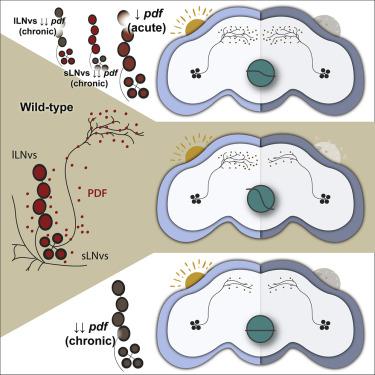Current Biology ( IF 9.2 ) Pub Date : 2020-07-02 , DOI: 10.1016/j.cub.2020.06.009 Anastasia Herrero 1 , Taishi Yoshii 2 , Juan Ignacio Ispizua 1 , Carina Colque 1 , Jan A Veenstra 3 , Nara I Muraro 1 , María Fernanda Ceriani 1

|
We have previously reported that pigment dispersing factor (PDF) neurons, which are essential in the control of rest-activity cycles in Drosophila, undergo circadian remodeling of their axonal projections, a phenomenon called circadian structural plasticity. Axonal arborizations display higher complexity during the day and become simpler at night, and this remodeling involves changes in the degree of connectivity. This phenomenon depends on the clock present within the ventrolateral neurons (LNvs) as well as in glia. In this work, we characterize in detail the contribution of the PDF neuropeptide to structural plasticity at different times across the day. Using diverse genetic strategies to temporally restrict its downregulation, we demonstrate that even subtle alterations to PDF cycling at the dorsal protocerebrum correlate with impaired remodeling, underscoring its relevance for the characteristic morning spread; PDF released from the small LNvs (sLNvs) and the large LNvs (lLNvs) contribute to the process. Moreover, forced depolarization recruits activity-dependent mechanisms to mediate growth only at night, overcoming the restriction imposed by the clock on membrane excitability. Interestingly, the active process of terminal remodeling requires PDF receptor (PDFR) signaling acting locally through the cyclic-nucleotide-gated channel ion channel subunit A (CNGA). Thus, clock-dependent PDF signaling shapes the connectivity of these essential clock neurons on daily basis.
中文翻译:

将神经肽水平与果蝇时钟神经元的结构可塑性耦合。
我们之前曾报道过色素分散因子 (PDF) 神经元,这对于控制果蝇的休息活动周期至关重要,经过昼夜节律重塑其轴突投影,这种现象称为昼夜节律结构可塑性。轴突分支在白天表现出更高的复杂性,在夜间变得更简单,这种重塑涉及连接程度的变化。这种现象取决于腹外侧神经元 (LNvs) 以及神经胶质中存在的时钟。在这项工作中,我们详细描述了 PDF 神经肽在一天中不同时间对结构可塑性的贡献。使用不同的遗传策略在时间上限制其下调,我们证明即使是背侧原大脑 PDF 循环的细微改变也与受损重塑相关,强调其与特征性早晨传播的相关性;从小型 LNvs (sLNvs) 和大型 LNvs (lLNvs) 发布的 PDF 有助于该过程。此外,强制去极化招募活动依赖机制仅在夜间调节生长,克服时钟对膜兴奋性的限制。有趣的是,末端重塑的主动过程需要 PDF 受体 (PDFR) 信号通过环核苷酸门控通道离子通道亚基 A (CNGA) 在局部起作用。因此,依赖于时钟的 PDF 信号每天都会塑造这些基本时钟神经元的连接性。末端重塑的主动过程需要 PDF 受体 (PDFR) 信号通过环核苷酸门控通道离子通道亚基 A (CNGA) 在局部起作用。因此,依赖于时钟的 PDF 信号每天都会塑造这些基本时钟神经元的连接性。末端重塑的主动过程需要 PDF 受体 (PDFR) 信号通过环核苷酸门控通道离子通道亚基 A (CNGA) 在局部起作用。因此,依赖于时钟的 PDF 信号每天都会塑造这些基本时钟神经元的连接性。



























 京公网安备 11010802027423号
京公网安备 11010802027423号